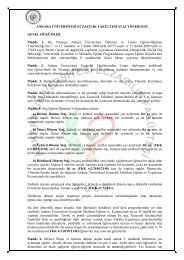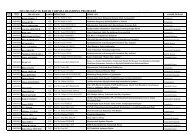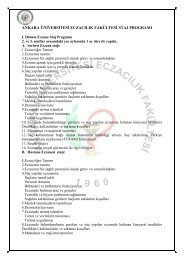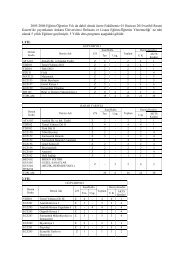Faculty of Pharmacy
Faculty of Pharmacy
Faculty of Pharmacy
You also want an ePaper? Increase the reach of your titles
YUMPU automatically turns print PDFs into web optimized ePapers that Google loves.
Pathophysiology <strong>of</strong> diseases: Hypertension, heart failure-shock, arrhythmia, atherosclerotic heart<br />
disease, peptic ulcer, inflammated bowel diseases, liver diseases, constipation and diarrhea, gout,<br />
inflammation and Immunity, acute and chronic renal failure, Iymphoma, leukemia, rheumatoid<br />
arthritis, osteoporosis, thyroid gland diseases, diabetes mellitus, chronic obstructive pulmonary<br />
disease, tuberculosis. Definition and mechanisms <strong>of</strong> inflammation, hypoxia, ischemia, cyanosis.<br />
Regulation <strong>of</strong> body temperature and pathophysiology <strong>of</strong> fever. Definition, mechanism and types <strong>of</strong><br />
pain. Vascular fluid regulation, pathophysiology <strong>of</strong> edema, clinical types <strong>of</strong> edema. Fluid-electrolyte<br />
balance and disturbances, hypervolemia and hypovolemia. Acid-base balance and disturbances.<br />
Kidney function disturbances. Kidney failure. Atherosclerosis, coronary artery diseases, myocard<br />
infarction pathophysiology. Definition <strong>of</strong> hypertension, Causes <strong>of</strong> primary and secondary<br />
hypertension, mechanisms and complications. Mechanisms <strong>of</strong> heart failure, left and right heart<br />
failure, pulmonary hypertension. Definition <strong>of</strong> shock, pathophysology, causes and types <strong>of</strong> shock.<br />
Causes <strong>of</strong> obstructive and restrictive respiratory diseases. Pathophysiology <strong>of</strong> allergy, anaflaxia and<br />
asthma. Mechanisms <strong>of</strong> hypothalamus-hypophysis axis disorders. Pathophysiology <strong>of</strong><br />
hyperthyroidism and hypothyroidism. Bone and mineral metabolism and disorders. Disorders <strong>of</strong><br />
blood glucose regulation: hyperglycemia and hypoglycemia. Pathophysiology and complications <strong>of</strong><br />
peptic ulcer. Causes and mechanisms <strong>of</strong> diarrhea and constipation. Disorders <strong>of</strong> gall bladder and bile<br />
duct, causes <strong>of</strong> jaundice. Liver function disorders. Liver failure and hepatitis. Definition, mechanisms,<br />
reasons and types <strong>of</strong> anemia. White blood cell disorders, leucopenia, leukocytosis, leukomoid<br />
reaction, lymphoma and leukemias. Disorders <strong>of</strong> homeostatic regulation I: Vascular and coagulation<br />
disorders. Disorders <strong>of</strong> homeostatic regulation II: Thrombocyte disorders and disseminated<br />
intravascular coagulation. Autoimmune and collagen tissue disorders.<br />
(ECZ481) PHARMACOGNOSY III (T)<br />
HOUR/WEK :2, ECTS :3<br />
Definition <strong>of</strong> alkaloids distribution in plant kingdom will be described. Classification, botanical source,<br />
pharmacological activity and uses <strong>of</strong> alkaloids will be given. Further information will be mentioned<br />
about isolation, identification and analysis <strong>of</strong> these active alkaloidal substances. Information on<br />
enzymes, protits, vaccines and serums also will be given.<br />
(ECZ483) PHARMACOGNOSY III PRACTICE (P)<br />
HOUR/WEEK :4, ECTS:3<br />
Microscopic characters, identification, isolation, pharmacopeial analysis, qualitative and quantitative<br />
analysis <strong>of</strong> the drugs containing alkaloid substances will be given experimentally.<br />
(ECZ485) PHARMACEUTICAL CHEMISTRY III (T)<br />
HOUR/WEEK :2, ECTS:2<br />
The mission <strong>of</strong> the Pharmaceutical Chemistry III course is to introduce students to the chemical<br />
formula, general physico-chemical and structural properties, synthesis, chemistry <strong>of</strong> metabolites<br />
structure-activity relationships <strong>of</strong> pharmaceutical agent. Topics include Cholinergic drugs: 1.<br />
Parasympathomimetics, 2. Anti-cholinesterase drugs, Neuromuscular blocking drugs, ganglion










